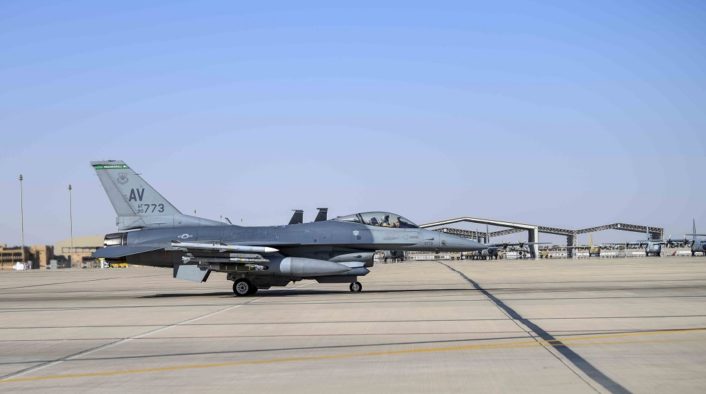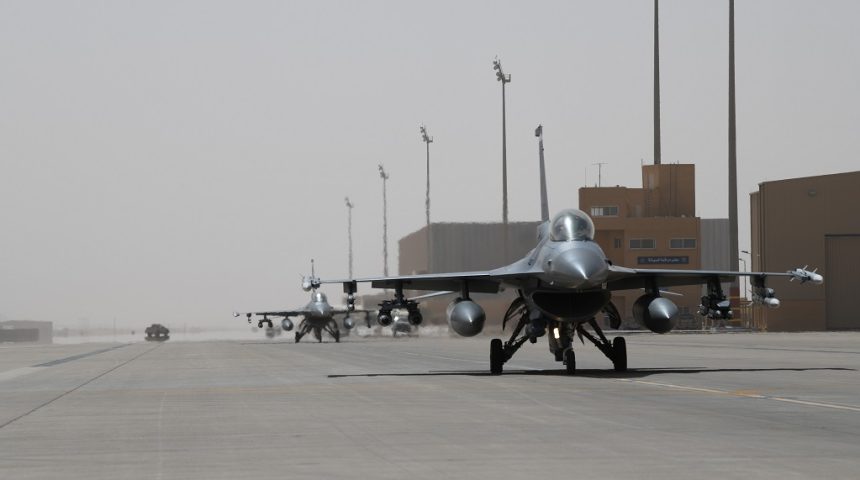The squadron has now been relocated to Prince Sultan Air Base, Saudi Arabia, for the second part of the deployment.
The 555th Fighter Squadron, also known as the “world famous, highly-respected” Triple Nickel, completed the first F-16 deployment in 15 years at Al Udeid Air Base (Qatar) in late February 2020. The squadron deployed from Aviano Air Base, Italy, in late October 2019 to support combat operations for Operations Spartan Shield and Inherent Resolve, flying more than 840 missions and nearly 5,000 hours in less than 120 days.
“AUAB hadn’t seen F-16s in over a decade,” said Master Sgt. Nathan Tierney, assistant superintendent of the Triple Nickel maintenance unit. “We had to convert one of the parking ramps, which was built to house B-52’s, into a usable F-16 ramp in only a week. This included coordinating a parking plan with the safety office, installing grounding points, painting new taxi lines, and setting up tents for major maintenance.”
The Triple Nickel deployed less than a week after it was tasked, under the new Agile Combat Employment model designed by the U.S. Air Force to enable rapid inter-theater movement to project combat air power regionally or across the globe. “The Triple Nickel is rapidly mobile, we’re lethal and we’re ready to deliver multi-role air-to-ground, air-to-air and standoff munitions anywhere, anytime,” said Lt. Col Beau Diers, commander of the 555 FS, after arriving at AUAB.

According to Master Sgt. Tierney, “Because our equipment and parts had not arrived yet and we were being tasked to support missions, we had Airmen scavenging parts from all the maintenance sections on base.” This was a direct demonstration of the adaptive basing concept following the 2018 National Defense Strategy’s call to be strategically predictable but operationally unpredictable, with the squadrons being able to operate on their own without support or with limited support at a foreign base. As this Author wrote in a previous article:
Another goal for the Air Force was presented by Gen. Goldfein during the AFA’s ASC 2018 Conference: “The next phase of work is preparing the Air Force we need for multi-domain operations—the convergence of military capabilities in any or all domains to achieve military objectives on a global scale. It is time to get back to our expeditionary roots.” This mean that the future Air Force needs to be able to operate during possible conflict scenarios in absence of fixed bases, infrastructure and C2 (Command and Control), with squadrons taking the lead and deploying with their entire organization and support elements to perform expeditionary operations at a foreign base. […] The Air Force is envisioning a force able to deploy anywhere and anytime to perform combat operations when needed and the F-35A is the pivotal element of this concept.
The squadron now relocated to Prince Sultan Air Base (Saudi Arabia) for the second leg of the deployment, continuing to follow the ACE model. The same employment model was experimented also last year with F-15s and F-35s across Europe and Africa and, more recently, with the first F-22 deployment to Al Udeid AB. The agile combat employment was further demonstrated last month with F-16 and F-35, departed from Al Dhafra AB (UAE), which exercised hot refueling operations at Prince Sultan AB.









